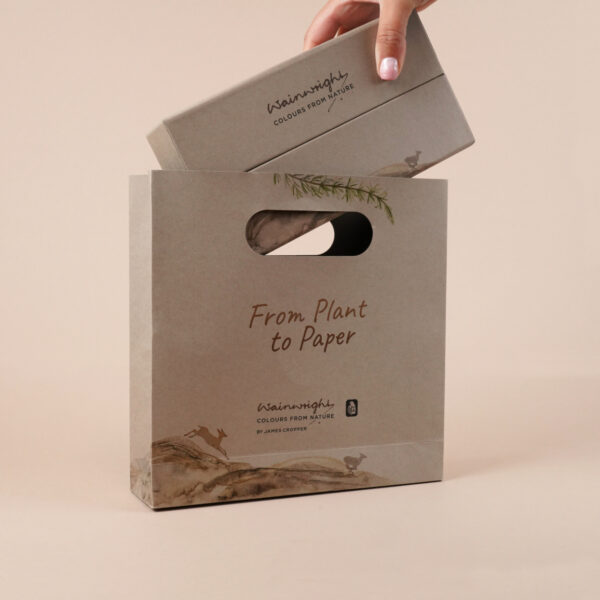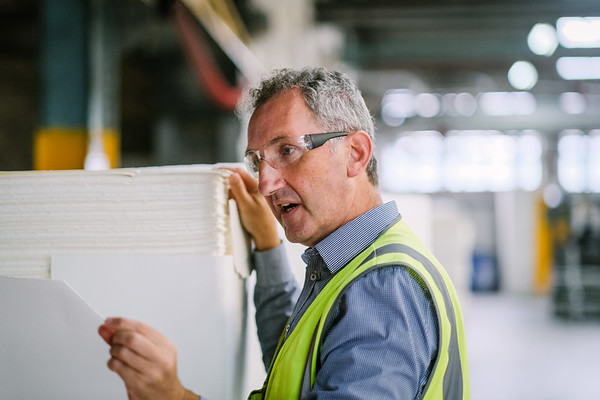
Boxing Clever

How choosing the right retail packaging can enhance your boutique's branding while convincing shoppers that your sustainability efforts are genuine with Kate Gilpin, Product Manager, Packaging.
JS:
What are premium end retailers looking for right now in terms of retail carrier bags, gift boxes, e-commerce packaging? What are the key trends in retail packaging?
KG:
Packaging has a practical role to play in protecting the product it contains and providing information about the product which the consumer needs or wants to know about. However, the role of packaging in telling the brand story is something which can’t be underestimated.
Key trends in retail packaging reflect the times which we are living in; becoming an expression of what the world has experienced in recent years and the issues which are in the forefront of the consumer mindset. Some of the trends include:
Sustainable Packaging
Brands in every sector are looking at ways to respond to increasingly environmentally conscious consumers and that means better packaging choices. Incorporating circular design into packaging is key. This means not only choosing alternatives to non-biodegradable materials such as plastics and rubber but also incorporating recycled materials and ensuring the packaging can then be recycled after use.
Socially significant messages are also a key part of this. Communicating with messaging such as “I used to be a coffee cup” or “plastic free” can really impact on customer loyalty.
E-commerce Packaging
The pandemic has accelerated the wider adoption of online shopping with more businesses of all sizes including online channels as part of their operations. With consumers having less contact with brands in person, the packaging plays a crucial role in the e-commerce journey - conveying brand identity and customer experience.
Retro Design
Retro designs are having a moment. Whether it’s drawing on packaging designs of yesteryear or re-issuing original designs in full – retro design in packaging gives that feeling of nostalgia. It’s easy to understand how the social impact of the pandemic, world focus on climate change and politics has created this yearning for happier times.
Key trends in retail packaging reflect the times which we are living in; becoming an expression of what the world has experienced in recent years and the issues which are in the forefront of the consumer mindset. Some of the trends include:
Sustainable Packaging
Brands in every sector are looking at ways to respond to increasingly environmentally conscious consumers and that means better packaging choices. Incorporating circular design into packaging is key. This means not only choosing alternatives to non-biodegradable materials such as plastics and rubber but also incorporating recycled materials and ensuring the packaging can then be recycled after use.
Socially significant messages are also a key part of this. Communicating with messaging such as “I used to be a coffee cup” or “plastic free” can really impact on customer loyalty.
E-commerce Packaging
The pandemic has accelerated the wider adoption of online shopping with more businesses of all sizes including online channels as part of their operations. With consumers having less contact with brands in person, the packaging plays a crucial role in the e-commerce journey - conveying brand identity and customer experience.
Retro Design
Retro designs are having a moment. Whether it’s drawing on packaging designs of yesteryear or re-issuing original designs in full – retro design in packaging gives that feeling of nostalgia. It’s easy to understand how the social impact of the pandemic, world focus on climate change and politics has created this yearning for happier times.
JS:
How important are carrier bags and e-commerce packaging to a boutique/ retailer’s branding? How can they use these items to solidify their brand and stand out from competitors?
KG:
Carrier bags and packaging present a huge opportunity for retailers to project the values of the business and create consumer engagement and ultimately loyalty. A great example is British retailer Selfridges which has won multiple awards for its innovative approach to sustainability; the business used packaging as another channel through which to illustrate this ethos. In a pioneering environmental move, Selfridges began collecting cups from its retail stores and offices and handing them over to James Cropper to upcycle them through its unique CupCycling™ process, into beautiful paper for the store’s iconic yellow carrier bags. This completely closed-loop recycling solution demonstrates the storytelling power which packaging holds.
JS:
Do you have any examples of retailers who have got standout retail carrier bags and gift boxes?
KG:
In addition to Selfridges, Mulberry is a wonderful example of standout storytelling through packaging. The famous Mulberry Green is the brand's signature shade and also emblematic of their commitment to social responsibility. The bespoke Mulberry Green colour was created at the James Cropper mill in 2015, working jointly with paper merchant, G.F Smith.
Having established international brand recognition of the Mulberry Green, the retailer wanted to take it to the next level and so every sheet of Mulberry Green paper which is used for their packaging now includes 20% CupCycling™ fibre from coffee cups and a further 30% from other post-consumer waste.
Our unique CupCycling™ by James Cropper story is featured on all of this packaging, letting consumers know that the same care which is taken in the production of the luxury product they have purchased, is also taken in the creation of its packaging.
Having established international brand recognition of the Mulberry Green, the retailer wanted to take it to the next level and so every sheet of Mulberry Green paper which is used for their packaging now includes 20% CupCycling™ fibre from coffee cups and a further 30% from other post-consumer waste.
Our unique CupCycling™ by James Cropper story is featured on all of this packaging, letting consumers know that the same care which is taken in the production of the luxury product they have purchased, is also taken in the creation of its packaging.

JS:
How is the sustainability movement impacting retail packaging? Are you moving towards a more conscious approach as a company and what specific eco options do you offer retailers for in-store purchases and e-commerce orders?
KG:
Sustainability has always been at the heart of our business, both through the innovations we offer our customers and the way in which we run our own operation. The sustainability movement is impacting every part of life and business…and when it comes to packaging, there is a need to radically reduce the impact it has on the environment.
Recent innovations which are supporting customers on their sustainability journey include CupCycling, the world’s first recycling process dedicated to upcycling take-away coffee cups. CupCycling is a technology that extracts the plastic lining which previously made cups impossible to be recycled and transforms the remaining paper fibre into luxurious papers for packaging – be that bags, folding or rigid boxes.
CupCycling fibre can be used as an inclusion in our thermoformed, moulded fibre packaging solution, which offers a premium alternative to plastic packaging and is completely bespoke.
Since launching CupCycling five years ago, our appetite for taking value from waste streams has grown and in 2020, we launched a new collection of papers for premium packaging. The Rydal Packaging Collection offers options which are 100% post-consumer waste recycled, 40% post-consumer waste recycled and 100% fresh fibre from responsible forestry sources.
Recent innovations which are supporting customers on their sustainability journey include CupCycling, the world’s first recycling process dedicated to upcycling take-away coffee cups. CupCycling is a technology that extracts the plastic lining which previously made cups impossible to be recycled and transforms the remaining paper fibre into luxurious papers for packaging – be that bags, folding or rigid boxes.
CupCycling fibre can be used as an inclusion in our thermoformed, moulded fibre packaging solution, which offers a premium alternative to plastic packaging and is completely bespoke.
Since launching CupCycling five years ago, our appetite for taking value from waste streams has grown and in 2020, we launched a new collection of papers for premium packaging. The Rydal Packaging Collection offers options which are 100% post-consumer waste recycled, 40% post-consumer waste recycled and 100% fresh fibre from responsible forestry sources.
JS:
What innovations can we expect to see coming through in retail packaging over the next few years?
KG:
Catalysed by the pandemic, as people continue to move the bulk of their purchasing online, they are also shifting to purchasing goods that may have been bought exclusively in-store historically. For example, a May 2020 McKinsey report found that some beauty brands were seeing e-commerce sales twice as high as pre-COVID-19 levels. As businesses move forward, e-commerce packaging will become a more significant part of the packaging experience.
We can expect to see connected packaging where physical packaging interlocks with smart devices. While physical packaging has various benefits such as design features that protect the product, shelf-appeal and a way to reinforce the brand experience, using smart features will allow the consumer another level of engagement with the brand. For example, the packaging could connect people to product information and brand storytelling through a mobile device or computer.
Likewise, as discussions about the environmental impact we make as a society come more and more into question, consumers are ever more environmentally conscious, requiring new packaging innovations. Industry must continue to advance and drive sustainable packaging innovations that increase the use of recyclable and compostable materials. Equally important is encouraging greater investment in reprocessing technologies that can forever change how packaging is designed, made and re-used.
Businesses of all sizes can put circular economy principles to work. They can start by rethinking the design and development of products and packaging so they can be recycled or repurposed easily and affordably.
We can expect to see connected packaging where physical packaging interlocks with smart devices. While physical packaging has various benefits such as design features that protect the product, shelf-appeal and a way to reinforce the brand experience, using smart features will allow the consumer another level of engagement with the brand. For example, the packaging could connect people to product information and brand storytelling through a mobile device or computer.
Likewise, as discussions about the environmental impact we make as a society come more and more into question, consumers are ever more environmentally conscious, requiring new packaging innovations. Industry must continue to advance and drive sustainable packaging innovations that increase the use of recyclable and compostable materials. Equally important is encouraging greater investment in reprocessing technologies that can forever change how packaging is designed, made and re-used.
Businesses of all sizes can put circular economy principles to work. They can start by rethinking the design and development of products and packaging so they can be recycled or repurposed easily and affordably.
Explore our Packaging Papers
Related









